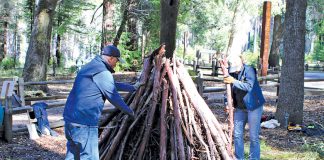
With so much rain this winter, it’s easy to forget just how precious water is. But globally, water is the new oil.
In our own Santa Margarita aquifer, everything we can do to replenish the groundwater is vital for our own survival and for that of generations to come.
Water costs money — to buy, store, collect, pump, filter and distribute. It just makes good sense to be water wise in your home and garden.
Scotts Valley Water District has been offering a free information series during January about water conservation. Each Wednesday night from 7 to 8:30 p.m., a different subject is presented. The talks are open to the public.
I’ve attended two so far: one on Storm Water Management and another on Rainwater and Greywater Harvesting. There is lots valuable information about ways to save water and money.
When it rains, it pours. Think about ways to slow this free water from the sky and prevent it from running off your property. Allow it to spread and sink into the ground. Easy ways to do this can also make for a beautiful landscape.
Design your patio using permeable pavers that allow rainwater to percolate into the soil. Whether you choose flagstone over a gravel base, pervious concrete, interlocking pavers with spaces between or crushed gravel, all enable rain to seep into the soil, recharge the aquifer and prevent runoff into streams and storm drains.
Large volumes of runoff often cause serious erosion and siltation in rivers and streams.
Pervious pavement for driveways can also capture runoff, recharge the groundwater and keep pollutants in place in the soil. That way naturally occurring microorganisms can digest car oils, leaving little but carbon dioxide and water.
Turf block — concrete blocks with holes — is a good choice for areas that don’t receive a lot of heavy traffic and can also be used for paths with gravel or groundcover between.
Plants and trees also slow water runoff. They help stabilize slopes and prevent erosion of valuable, nutrient-rich topsoil. They create wildlife habitat and act as a natural pest control. A beautifully designed landscape using California native or drought-tolerant plants reduces the need for fertilizers, pesticides, excessive watering and overall maintenance requirements.
You can design a rain garden to capture storm runoff from roofs, driveways and other impervious surfaces and allow the water to sink back into the ground. A dry creek bed can also be a good addition. Some people place drain pipes underneath to capture rainwater so it has time to percolate into the ground.
Using vegetation or mulches to cover bare soil is a key step to slow runoff. Mulches are a good choice for areas with less than 33 percent slope. Vegetation works well on areas with up to a 50 percent slope.
Mulch can be organic, such bark chips, straw or grass clippings, or inorganic gravel or cobbles. All protect soil from erosion, conserve soil moisture and prevent weed growth while helping slow, spread and sink water back into the ground.
Installing a rain barrel is a simple way to catch rainwater runoff from your roof. If you have room, you might consider a large water tank above or below the ground to collect water.
A friend of mine operates a small nursery on her Watsonville property. Sherry and her husband, John, decided to collect the rainwater runoff into a series of tanks to save money and make use of this resource. The 4,500-square-foot roof of their barn provides enough water to fill three large tanks. Last year, they collected enough water to irrigate their nursery, Terra Sole, for a good portion of the year. They eventually plan to install solar panels to offset the energy required to pump the water. Every little bit helps.
If you’d like more information and ideas about how to beautify your landscape and save water, maintenance costs and time please come to the last Water Wednesday presentation by Scotts Valley Water District at 7 p.m. Jan. 30 at 2 Civic Center Drive. LeAnne, the water conservation coordinator, and I will be showing slides of landscapes, some of which I designed, that feature low-water-use plants, lawn replacement ideas and California natives. There is a solution for every family and lifestyle.
– Jan Nelson, a landscape designer and California certified nursery professional, will answer questions about gardening in the Santa Cruz Mountains. Email her at ja******@*ol.com, or visit www.jannelsonlandscapedesign.com to view past columns and pictures.










